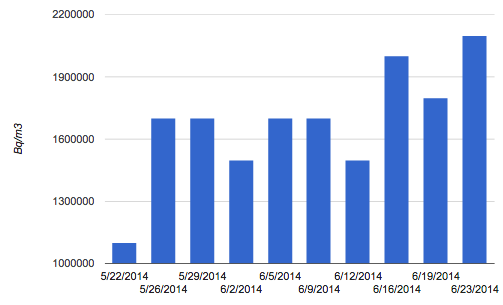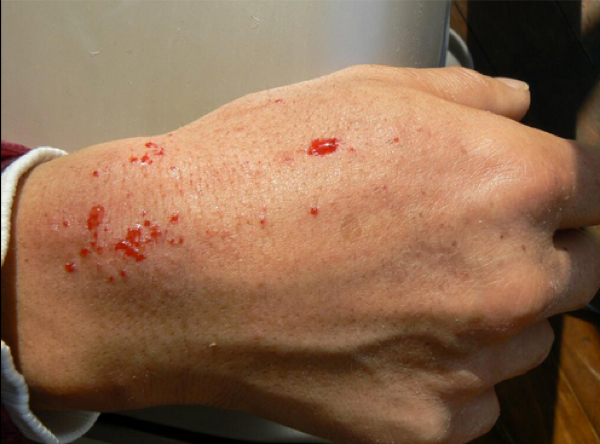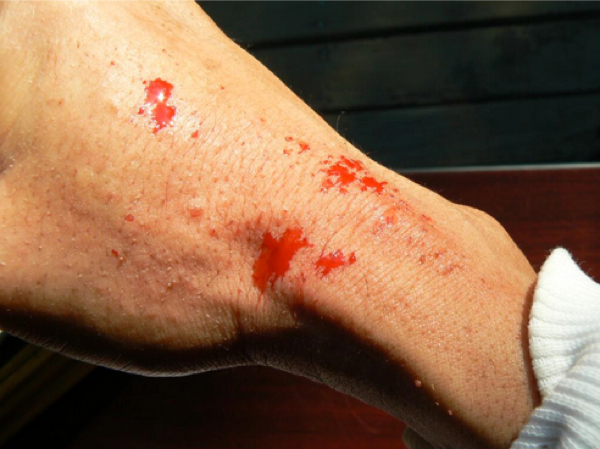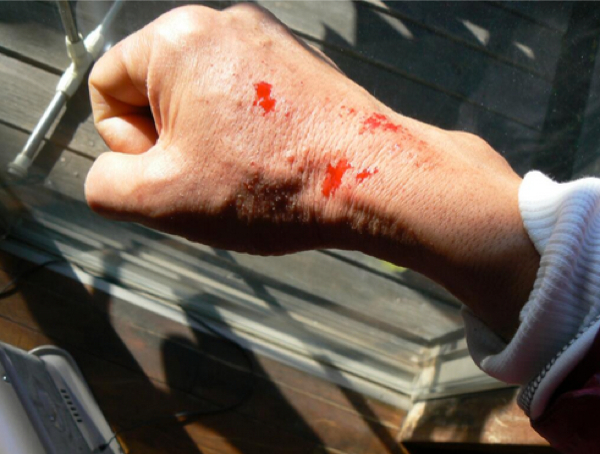Ex SKF
(Updated with information of the depth of the frozen soil wall holes, which is 30 meters)
The water was drawn from the lower permeable layer 20-meter deep, according to Kyodo News (6/24/2014) from an observation hole newly dug in preparation for monitoring the frozen soil impermeable wall that is to surround the reactor/turbine buildings of Reactors 1-4.
Cesium and all-beta (that includes strontium) are below detection levels, but tritium in 4-digit Bq per liter is apparently not what TEPCO has expected (or so they claim).
TEPCO's handout for the press on 6/24/2014 is about the observation hole No.H25J7 between the Reactor 3 turbine building and the Reactor 4 turbine building, whose water sample taken on June 10 was found with 140 Bq/L of tritium:
Energy News.....
Tepco finally admitted the “possibility” that contaminated water penetrated to the deep layer of the ground
Posted by Mochizuki on June 25th, 2014 · 3 Comments
Share on twitterShare on facebookShare on emailShare on printMore Sharing Services
Tepco finally admitted the possibility that contaminated water penetrated to the deep layer of the ground. Tepco announced in the extraordinary press conference of 6/24/2014.
Fukushima Diary has been pointing out the possibility for months.
(cf, Tritium density in deep underground broke the highest record ever, 4,700,000 Bq/m3 [URL])
Tepco was stating that the contaminated water reached 15m underground, but it’s stopped by impermeable layer right underneath.
However 120,000 ~ 140,000 Bq/m3 of Tritium was measured 25m underground from the sample of 6/10/2014 as well.
Tepco is still “under investigation” for the cause, but they are stating the construction of frozen water wall might have spread the contaminated water accidentally.
If the contaminated water is penetrating to deep layer of the ground, there are few measures to stop it spreading. It can also travel underground of the ocean bed to come up to the sea offshore of Fukushima plant.
WEDNESDAY, JUNE 25, 2014
(UPDATED) #Fukushima I NPP: 4700 Bq/L of Tritium Detected from Groundwater Taken from 20-Meter Deep Near Reactor 1/2 Turbine Building
(Updated with information of the depth of the frozen soil wall holes, which is 30 meters)
The water was drawn from the lower permeable layer 20-meter deep, according to Kyodo News (6/24/2014) from an observation hole newly dug in preparation for monitoring the frozen soil impermeable wall that is to surround the reactor/turbine buildings of Reactors 1-4.
Cesium and all-beta (that includes strontium) are below detection levels, but tritium in 4-digit Bq per liter is apparently not what TEPCO has expected (or so they claim).
TEPCO's handout for the press on 6/24/2014 is about the observation hole No.H25J7 between the Reactor 3 turbine building and the Reactor 4 turbine building, whose water sample taken on June 10 was found with 140 Bq/L of tritium:
However, the handout also shows the test results for the sample water drawn from the observation holes for future monitoring of the frozen soil impermeable wall (whose construction has just started around the corner of the Reactor 1 building), Fz-4, Fz-5, and Fz-8.
The water sample drawn from the frozen soil wall observation hole Fz-5 between the Reactor 1 turbine building and the Reactor 2 turbine building on June 4 was found with 4,700 Bq/L of tritium (in red rectangle below):
The water sample drawn from the frozen soil wall observation hole Fz-5 between the Reactor 1 turbine building and the Reactor 2 turbine building on June 4 was found with 4,700 Bq/L of tritium (in red rectangle below):
TEPCO's simplified cross-section drawing:
English labels are by me, but I don't pretend that I understand what they mean by "groundwater pressure for the lower impermeable layer" (green line in the diagram).
Kyodo News says this will likely delay the construction of the frozen soil impermeable wall because an added work of preventing the spread of contamination is necessary when drilling holes for the frozen soil wall. The holes for the frozen soil wall are to be 30-meter deep.
The construction of frozen soil wall is already a challenge of dodging the underground structures (trenches, pipes, and other facilities) that TEPCO doesn't quite know about. No one apparently knows what's underneath the surface, after 40-plus years of plant operation and continuous construction and maintenance of the site. I suppose that problem would be the same whether it is Kajima's frozen soil wall or more traditional wall of sheet piles, as proposed by Kajima's competitors. (Not that it is any consolation.)
But this is hardly a piece of news, hardly anyone cares, as Japan's politicians, mainstream media and alternative media and social media are abuzz and obssessed with "sexist heckling" by a fifty-something LDP male politician in Tokyo Metropolitan Assembly against a 35-year-old assemblywoman whose former life was a pin-up girl for men's magazine and a minor TV "talento (talent, or personality)".
Kyodo News says this will likely delay the construction of the frozen soil impermeable wall because an added work of preventing the spread of contamination is necessary when drilling holes for the frozen soil wall. The holes for the frozen soil wall are to be 30-meter deep.
The construction of frozen soil wall is already a challenge of dodging the underground structures (trenches, pipes, and other facilities) that TEPCO doesn't quite know about. No one apparently knows what's underneath the surface, after 40-plus years of plant operation and continuous construction and maintenance of the site. I suppose that problem would be the same whether it is Kajima's frozen soil wall or more traditional wall of sheet piles, as proposed by Kajima's competitors. (Not that it is any consolation.)
But this is hardly a piece of news, hardly anyone cares, as Japan's politicians, mainstream media and alternative media and social media are abuzz and obssessed with "sexist heckling" by a fifty-something LDP male politician in Tokyo Metropolitan Assembly against a 35-year-old assemblywoman whose former life was a pin-up girl for men's magazine and a minor TV "talento (talent, or personality)".
Energy News.....
Nuclear Consultant: Fukushima reactors released about 3 times more radioactivity than Chernobyl — Japan crisis is unprecedented in size, complexity, and consequences — Yet disaster is not over and can become much worse — Very far from being stabilized
TV: Trouble reported with inner ‘ice wall’ at Fukushima; Highly radioactive water underground won’t freeze — Tepco: “We can’t make temperature low enough” after trying for months; Fluctuating water levels beneath Unit 2 blamed — Expert: Ground can liquify around reactors, form sinkholes (VIDEO)
Fukushima Diary......
Posted by Mochizuki on June 25th, 2014 · 3 Comments
Share on twitterShare on facebookShare on emailShare on printMore Sharing Services
Tepco finally admitted the possibility that contaminated water penetrated to the deep layer of the ground. Tepco announced in the extraordinary press conference of 6/24/2014.
Fukushima Diary has been pointing out the possibility for months.
(cf, Tritium density in deep underground broke the highest record ever, 4,700,000 Bq/m3 [URL])
Tepco was stating that the contaminated water reached 15m underground, but it’s stopped by impermeable layer right underneath.
However 120,000 ~ 140,000 Bq/m3 of Tritium was measured 25m underground from the sample of 6/10/2014 as well.
Tepco is still “under investigation” for the cause, but they are stating the construction of frozen water wall might have spread the contaminated water accidentally.
If the contaminated water is penetrating to deep layer of the ground, there are few measures to stop it spreading. It can also travel underground of the ocean bed to come up to the sea offshore of Fukushima plant.
Tritium density reached the highest in one of the bypass wells again / Already double as one month ago
Posted by Mochizuki on June 25th, 2014 · No Comments
Following up this article.. Highest level of Tritium measured from a bypass well [URL]
From Tepco’s report on 6/25/2014, the Tritium density from the issued bypass well became the highest since they started measuring again.
The sample was taken on 6/23/2014. The reading was 2,100,000 Bq/m3. This is over the desired safety limit by 600,000 Bq/m3.
Tepco is still stating that the average Tritium density will be lower by mixing with lower contaminated water.
However based on the research of Fukushima Diary, the Tritium density is in the increasing trend since the end of May. Now it’s already 1.9 much of one month ago.
Related article.. Bypass water discharge to the Pacific turned out “meaningless” / Tepco to continue for a few more months [URL 2]
Bypass water discharge to the Pacific turned out “meaningless” / Tepco to continue for a few more months
Posted by Mochizuki on June 22nd, 2014 · 4 Comments
Bypass water discharge has not decreased groundwater flowing to the plant buildings at least by now.
It has been a month since Tepco started pumping up contaminated groundwater to discharge to the Pacific. They have discharged 6,800 t of contaminated groundwater in total.
However, no decrease has been confirmed in the volume of groundwater flowing to the basement of the plant buildings.
Approx. 400 t of groundwater flows into the plant buildings every single day. Tepco was estimating the bypass project would decrease it by 50 ~ 100 t a day.
Tepco is stating they need a few more months to see the effectiveness.
Bypass water discharge, frozen water wall and ALPS are all Japanese government has as measures against the contaminated water issue.
However, ALPS has never been in full operation since last year due to the continuous problems in all of 3 systems. Preceding frozen water wall hit a snag. There is the possibility that all of the measures fall through.
Related article.. Highest level of Tritium measured from a bypass well [URL]
[Photo] Fukushima decontamination volunteer “Blood suddenly splashes out of skin quite often. This is the reality.”
Posted by Mochizuki on June 21st, 2014 · 7 Comments
A Fukushima decontamination volunteer commented on Twitter that the skin bleeds suddenly.
His pictures look like he had just dry skin, but Fukushima Diary judged he rationally can’t mistake it to just a normal dry skin.
“I’ve been involved in this Fukushima volunteer for 3 years.
Blood splashes out of the skin suddenly, and quite often. This is the reality.”
Fukushima Diary covered that he had cancer last year too.







Good morning Fred, I checked out the further WND articles you posted in the comments. I get it, there is a lot of fear mongering going on and ISIS will be a great excuse for all sorts of military incursions,
ReplyDeleteThe "Chinese warehouse" scandal seems to be still growing.
I would say those poor people near Fukushima but I think it's really us poor people in the northern hemisphere. I guess we are a good deal safer here in N. America but how much so is open for speculation.
Have a great day
Morning Kev . I posted the WND just at the comment and lot in the blog post for the precise reason of the agenda posited in both articles ( while noting there are some things to consider within both articles. ) ISIS is not just an excuse but a way to overlook the drivers of the insurrection by not just the Sunnis under Maliki - but also the Kurds. Lots of chickens coming home to roost in Iraq these days.
DeleteChina ponzi scheme will become larger - especially once the banks are forced to look under the hood and discover where things truly stand ( and then take write downs on all of those loans. )
I agree Fukushima is not just a Japan and Asian Regional problem , but a Northern Hemisphere problem. The of course we have WIPP in New Mexico and Hanford in Washington state ( more Northern Hemisphere / West Coast of US problems. ) Ukraine has nuclear reactors and we know about the civil war there. Wonder if one of those reactors falls prey to a false flag attack in the medium term ? To sum up , very much is open to speculation these days !
Enjoy your day !